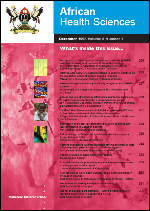
|
African Health Sciences
Makerere University Medical School
ISSN: 1680-6905
EISSN: 1680-6905
Vol. 19, No. 3, 2019, pp. 2378-2389
|
 Bioline Code: hs19126
Bioline Code: hs19126
Full paper language: English
Document type: Research Article
Document available free of charge
|
|
|
African Health Sciences, Vol. 19, No. 3, 2019, pp. 2378-2389
| en |
Isolation of Janthinobacterium lividum  from early onset neonatal sepsis patients in Malaysia from early onset neonatal sepsis patients in Malaysia
Shinkafi, Sa’adatu Haruna; Umar, Shu’aibu; Neela, Vasantha Kumari; Noordin, Sabariah Moh’d; Noordin, Syafinaz Amin; Hudu, Shuaibu Abdullahi & Zainudin, Zurina
Abstract
Background: The term early onset neonatal septicaemia (EONS) refers to invasive bacterial infections that primarily involve the blood stream of neonates during the first 3 days of life. Although early onset neonatal septicaemia is relatively uncommon, it may be associated with case fatality rates of 15-30% and substantial morbidity in surviving infants.
Objectives: This study describes an unusual septicaemia cases with Janthinobacterium lividum in neonatal Intensive Care Units.
Methods: Bacterial causes of early onset neonatal sepsis in Kuala Lumpur Hospital Malaysia were investigated using broad range 16S rDNA PCR and sequencing. The bacterial DNA was isolated directly from blood without pre-incubation. All samples collected were equally cultured and incubated in automated BACTEC system.
Results: Two hundred and fifty two neonates were recruited in this study with mean (SD) gestational age of 35.9. Neonates with J. lividum infection lacked microbiological evidence of septicaemia as their blood culture yielded no bacterial growth. However, the PCR analysis of these samples yielded 1100bp corresponding to bacteria species.
Conclusion: This study demonstrates the value of PCR in detecting bacteria where special growth requirement is involved.
Keywords
Janthinobacterium lividum; neonatal septicaemia; neonatal intensive care units.
|
| |
© Copyright 2019 - Shinkafi et al.
|
|
